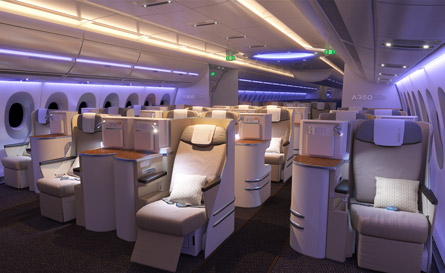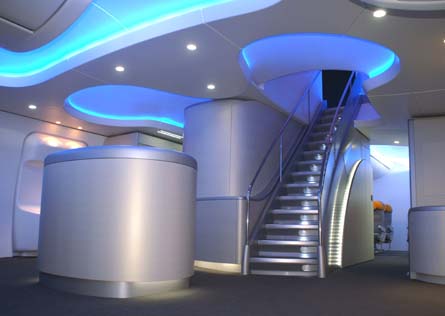While passenger comfort is largely a matter of seat features, in-flight entertainment (IFE) content and onboard service quality - all operator choices beyond the airframer's control - the manufacturers have to give their aircraft a competitive edge through the arguably less exciting furnishings around the cabin outline.
Blake Emery, Boeing's director of differentiation strategy, says that the objective thus far has been to distract passengers from the fact that they are flying. In other words: soon after take-off, meals are served and the window blinds pulled down to enjoy the IFE system for as long as possible until arrival. The airframer wanted to improve comfort levels through a different approach for the 787.
 |
|---|
| © Airbus Lighting sets the mood on the A350 |
"With the new philosophy, we want to celebrate that we are in the sky," says Emery. "The innovations are designed to connect the travellers more strongly with the flying experience."
The most prominent feature of this concept is the larger passenger window. It has been made 30% bigger than on "similarly sized airplanes today" not only to improve the view to the outside, but also to allow more natural light into the cabin. Plain, opaque blinds have been omitted in favour of a more sophisticated electronic system, which reduces the window's transparency from full clarity to a dark shade comparable to strong sunglasses at the push of a button. This can be done individually as well as centrally by the crew. The idea is that passengers "never lose connection" with the aerial landscape, says Emery.
Airbus has also increased the window size for the A350 by roughly 20% versus the A380. The target was to improve the vision for passengers with as broad a range of body heights as possible, explains Zuzana Hrnkova, head of interiors marketing. The airframer took a different route for the sunshades, however.
Nearly all airlines requested standard, mechanical blinds due to their uncomplicated design and light weight, says Hrnkova. She says that "one of the early A350 customers" ordered electrically operated blinds. Diehl Aerospace, which will supply the side and ceiling panels as well as overhead bins for the new long-range twinjet, has developed an electrically driven system, which comprises a conventional opaque and separate semi-transparent shade. Nevertheless, Hrnkova adds that the interior designers have allocated space to employ "any technology available", including window dimming, if requested.
ARCHITECTURAL DEPTH
Boeing designed the entry area around the main passenger doors on the 787 and 747-8 more generously to create a spacious and inviting atmosphere during boarding. This has been achieved both through allocating more space and by incorporating new architectural features into these zones. While the 787 door entry area has a high arched ceiling, this was not possible on the 747-8 due to the upper deck. The cabin designers instead expanded the space sideways and incorporated the staircase as well as a reception-style counter for the purser's work station in the layout for greater "architectural depth", explains Emery.
Improving the usability and appearance of the overhead bin is a central focus of Diehl, because the stowage compartments are a main - and in times of hold baggage charges increasingly relevant - touchpoint between passengers and aircraft. The company developed a hinge mechanism for the overhead bins on the A380, which reduces the passenger's effort to close the laden compartment by around 40%. Boeing has meanwhile introduced a similar system for "Sky Interior"-equipped 737, 747-8 and 787 aircraft.
 |
|---|
| © Boeing The Boeing 747-8I entry area is designed to be inviting |
Diehl did not merely develop the more complicated installation - which comes at a certain weight penalty - to increase comfort levels over existing equipment, but also because the new hat racks had to satisfy conflicting requirements. While the bins need to become larger due to growing hand luggage volumes, they also have to recede higher up into the ceiling to create a more spacious interior, explains Bernhard Bertrams, senior vice-president for business development, marketing and sales.
At the same time the fuselage dimensions have increased on the A380, while the passengers still have to be able to open and close the compartments without having to step into the seat rows. The mechanism, on the other hand, has to remain as compact as possible in order not to waste stowage space.
Diehl is now working on electrically driven overhead bins. No airframer has yet selected the technology, but Bertrams is sure that the "development will not stop at the current mechanical closing system". While electric bins could be centrally operated by the crew, it will still be necessary for passengers to be able to open individual compartments to access their luggage during the flight and that there be a mechanical fall-back option if the electrics fail.
Side panels might not be a significant touch point for travellers - their design indeed aims to be as slim as possible to avoid contact with passengers and wasting valuable cabin space. Their construction is nonetheless complex as they have to serve multiple purposes.
NOISE REDUCTION
One is to absorb noise from outside as well as inside the cabin. Suppliers have experimented with perforated surfaces to allow interior noise to be muffled rather than reflected by the hard panels. But cleaning detergents and other liquids could then penetrate the components or accumulate in the openings, thus compromising the acoustic effect.
Diehl has worked with sound-permeating foils which allow noise to travel through the surface and be absorbed inside, reports Bertrams. But this is still under development and requires further testing. He adds that the company is separately working to quieten a broad range of noise sources among its cabin equipment, be it rattling service trolleys in their galley slots or the closing of stowage bin and lavatory doors.
A lot of effort has been spent on reducing noise generated by the airflow going through the ducting of the air-conditioning system. Small spades have, for example, been introduced inside the ducts at turning points to direct the airstream so that it does not hit the vessel's interior surface. As tight passages accelerate the airflow and thus reduce its temperature, these sections need to be heated and had to be made out of metal in the past. Composite materials have allowed new solutions in complicated areas where higher noise levels were previously accepted as a compromise, says Bertrams.
Lighting has become a major means to create cabin ambience and improve passenger comfort in recent years. While the 777 and A330 have been fitted with conventional light bulbs and tubes - LED lighting is optionally available - the 787, 747-8 and A350 come with the new-generation equipment as standard.
 |
|---|
| © Airbus Diehls hinge mechanism makes closing stowage compartments easier on the A380 |
Mood lighting, which can replicate sunsets and sunrises with gradual changes between light and darkness, can help passengers to sleep and wake at appropriate times to reduce the effects of jetlag during long-haul flights, according to Walter Fleischmann, senior vice-president for avionics and cabin customisation interior at Diehl. He reports that scientific studies with universities in autumn 2011, for which the company simulated long-range flights with test subjects in a mock-up, proved that the coloured lighting has an influence on travellers' well-being.
But the new technology also opened up possibilities to use light for more accentuated interior design. Instead of using monochrome light tubes, Boeing installs a double-row of LEDs above the overhead bins on 787, 747-8 and 737. One projects white light against the opposite bin while the other illuminates the ceiling in colour. Dark blue can make the cabin appear taller and more spacious, for example, while red creates a more intimate atmosphere.
While the LED technology has thus far been imaginatively used mainly on long-range aircraft, Fleischmann sees growing application on short-haul aircraft in future. However, the focus will in that case not be on improving passenger comfort levels, but to emphasise the airline's branding.
Source: Flight International



















